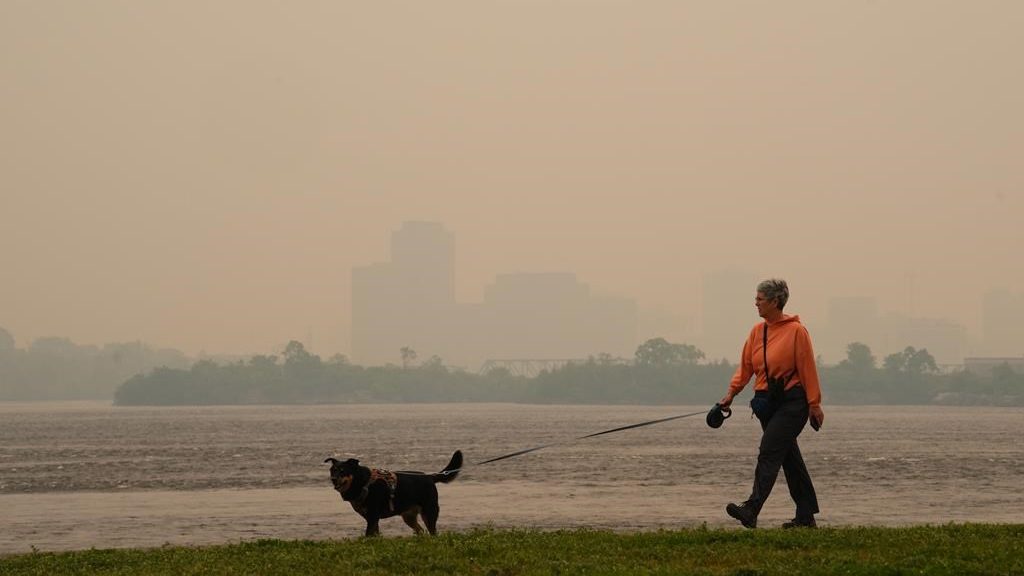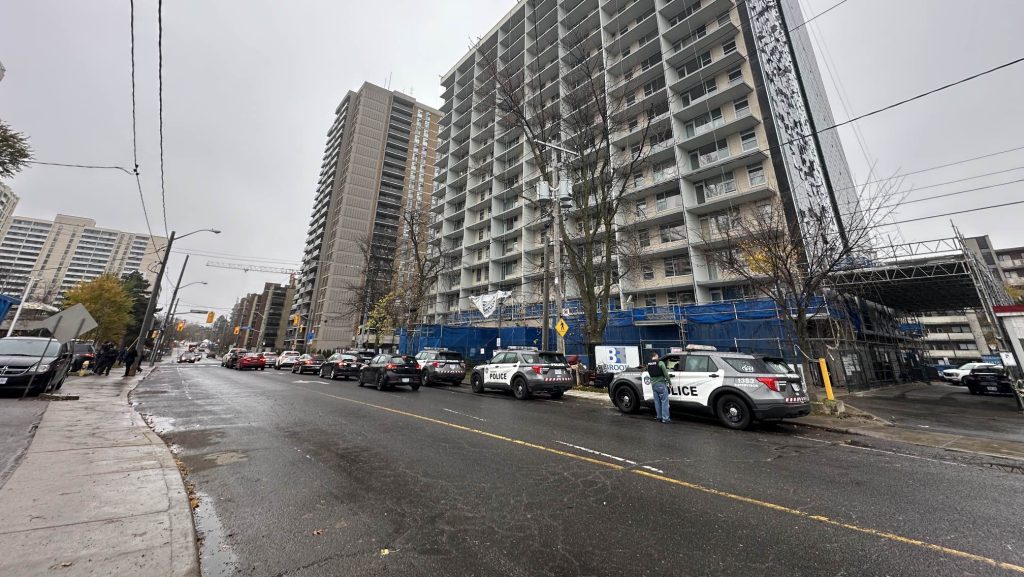Canada marks Clean Air Day with worst air quality in the world as wildfires rage

Posted June 7, 2023 9:56 pm.
OTTAWA — Hazy skies tinged with an eerie yellow glow greeted millions of Canadians in Quebec and Ontario again Wednesday as the smoke from hundreds of wildfires continued to cause air quality warnings in Canada’s most populated corridor.
In a bizarre twist of fate, as the country saw one of the worst days it’s ever seen for air quality, it was national Clean Air Day in Canada.
“People across the country are being affected,” Prime Minister Justin Trudeau said on Parliament Hill.
“We’re seeing vulnerable people at risk, outdoor events cancelled, kids having to be kept inside at recess.”
In the morning, Environment Canada’s air quality health index listed Ottawa and Gatineau, Que., as the worst in Canada, with a very high risk warning. They were followed closely by the eastern Ontario cities of Kingston, Cornwall and Belleville.
Residents in those cities were encouraged to limit outdoor activities, and those most vulnerable to the smoke were told to avoid them altogether.
By late afternoon, the risk had eased somewhat in eastern Ontario as winds shifted the smoke closer to the Greater Toronto Area and Hamilton.
Forecasts suggest that the GTA, the Niagara region and southwestern Ontario are due to see the highest risks because of bad air quality on Thursday and Friday, while the risk level in Ottawa will drop.
The eastern United States is also seeing devastating effects from wildfire smoke drifting south from Canada, with cities like New York and Washington, D.C., issuing air quality warnings of their own.
Trudeau spoke Wednesday with U.S. President Joe Biden about the wildfires and the effect on air quality in both countries, the Prime Minister’s Office said in an official summary of the conversation.
“Both leaders acknowledged the need to work together to address the devastating impacts of climate change,” the statement read.
The Canadian Interagency Forest Fire Centre database showed Wednesday afternoon that 440 fires were burning in nine provinces and two territories. More than half were considered out of control.
The amount of land burned surpassed the 40,000-square-kilometre mark Wednesday, making the 2023 fire season Canada’s fourth-worst on record before the summer has even officially begun.
At the current pace of burning, the all-time record is expected to be surpassed by next week.
“By all measures, this is perhaps the worst year we have experienced with wildfires,” Emergency Preparedness Minister Bill Blair said.
He said it is a blessing there has been no loss of life, but property damage has been significant, and major infrastructure is being hit, too. For example, Blair said that in Quebec, some hydro towers are in jeopardy.
On Vancouver Island, a small wildfire cut off the only major highway linking Port Alberni, Tofino and Ucluelet to the rest of British Columbia.
Alberta has lifted its state of emergency following a very difficult May, during which 314 fires burned more than 12,000 square kilometres of forest and prompted thousands of people to flee their homes. Still, 65 fires remain burning in that province, 17 of them out of control.
In Nova Scotia, the Tantallon fire that destroyed 151 homes has been contained, but the Barrington Lake fire, which has damaged or destroyed at least 60 homes and cottages, remains out of control.
Quebec is now facing the toughest challenge, with 163 fires burning, 117 of them out of control. The Quebec fire situation flared up extremely fast. Just a week ago, there were only 16 fires in the province, and they had burned about 215 square kilometres.
In the last week, another 6,500 square kilometres have burned.
Wednesday’s air quality warnings prompted school boards in Ottawa and the Toronto area to hold recess indoors and some sports leagues cancelled outdoor games and practices.
Individuals were also changing their plans to enjoy the great outdoors and donning face masks when they were outside.
Yili Ma, 31, said a hiking group she belongs to has cancelled its plan to hike near the Toronto Zoo this week because of the air quality in Toronto.
“And also I’m not considering going to any patio. I put my mask away for over a year, and now I’m putting on my mask since yesterday.”
Others are worrying about what this extreme fire season says about the future.
Oksana Perekhidouk said she initially thought it was fog marring the view from her 31st-floor apartment in Ottawa.
“It turns out it is smoke, and it’s not good. So, I’m really worried, not even about the air condition, but about the forest,” said Perkhidouk.
Brendan Lyver, 25, said it’s frustrating that it is unhealthy to be outside.
“Forest fires, especially out east in Nova Scotia, that’s not a common occurrence,” he said. “So that’s definitely something we need to address and look at what’s going on in the environment right now.”
The federal government is focused on battling the fires for now, but Trudeau acknowledged Wednesday his government is discussing the idea of creating some kind of national disaster response agency.
“We need to continue to make sure we are doing everything possible to keep Canadians safe when these extreme weather events happen, but also make sure we’re doing everything we can to predict, protect, and act ahead of more of these events coming,” he said.
“So we continue to discuss and look at new mechanisms and new ways of doing that.”
A senior government source told The Canadian Press that those discussions include analyzing models like the Federal Emergency Management Agency in the United States.
FEMA leads the U.S. government’s programs to prepare for, prevent, respond and recover from natural disasters, terrorist attacks and other major incidents.
In Canada, initial disaster responses are currently the responsibility of municipal and provincial governments, which can ask for federal help when needed. Most often, that involves deploying the Canadian Armed Forces.
That happened 21 times between 2018 and 2022, not including 118 requests for help from the military in 2020 to respond to COVID-19.
Chief of the Defence Staff Gen. Wayne Eyre has warned that the high demand on his troops for disaster assistance is straining the military’s overall capacity.
More than 500 soldiers and military specialists were deployed in Alberta, Quebec and Nova Scotia in response to the fires as of Wednesday, along with equipment including waterbombers and other aircraft.
Nearly 1,000 international firefighters from the United States, South Africa, Australia and New Zealand were also in Canada to help, with another 109 expected to arrive in Quebec from France.
This report by The Canadian Press was first published June 7, 2023.
— With files from Jordan Omstead and Kiernan Green in Toronto, Beth Leighton in Vancouver and Liam Fox in Ottawa.
Mia Rabson, The Canadian Press








